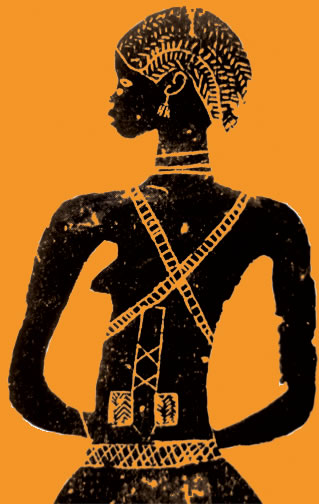
Mural from Bidjagos Islands, Guinée-Bissau,
(off the westernmost coast of Africa).
This matrilineal society has a history of strong
female leadership in politics and religion—and of
marriage proposals traditionally initiated by women
Click to see full video of
"Restoring Women to Cultural Memory"
Restoring Women to Cultural Memory
History is the quarrels of popes and kings, with wars and pestilences in every page;
the men all so good for nothing, and hardly any women at all. —Jane AustenMax Dashu
Most history passes over women. Our names and faces are missing, our stories omitted or distorted, and covered over by an endless masculine litany of kings, warlords, priests (with an occasional queen or concubine --- often a woman blamed for ruining everything).
But women have exercised power and determined the course of events and the forms of human culture. Women founded, governed, invented and created. We have been leaders, prophets, scribes and authors, warriors and rebels against oppression, fighting for our rights and for our peoples.
Girls and women suffer from a lack of knowledge about societies that accord power to women in public life: in religion, medicine, the arts, diplomacy, land management and inheritance. These crucial silences and omissions create the demoralizing impression that women have always been beneath men. Which is false.
In classic Eurocentric history, women end up as footnotes to the “main” story. Sandra Cisneros said of the search for Latina heroines, “We are the footnotes of the footnotes.” And yet the heritages of women of color, especially indigenous women, supply the most dramatic recent examples of societies that embraced open female power.
Even the tendency to focus on famous women or rulers is a distortion. We understand more if we expand our vision to include entire groups of creative and honored women, the inventors and clan elders, the healers, shamans, and priestesses. There is a clear interplay between these spiritual offices and political power in many indigenous societies.
Power itself has been conceived of very narrowly, as domination, force, and supremacy—top-down command, grasping and seizing goods and grinding down people, despoiling nature. These systems are more than patriarchal; they are colonial and imperial.
Looking past these blinkers will give us a broader view of reality, one that takes in female spheres of power: Cultural. Foundational. Political. Social. Economic. Technological. Religious. Artistic. Medical. Scholarly. Physical. Agents of change and transformation.
There's always much more that could be said on such a vast topic, but this is just a start at re-envisioning the female, in quick strokes. Of empowered and formidable women, in all kinds of settings from the most favorable, egalitarian cultures to heavily male-dominated societies which decreed female submission, stigmatized women’s leadership and disdained their intellects and creativity.
Even under these extremities, there have always been strong spirits who defy tyranny and rise up to shine a light.
copyright 2008 Max Dashu
More on priestesses and power.
More on women's political power. More on women's social power.
This video is an extra from the Women's Power dvd.
Text for the extra on Early Female M.D.s can be read here.Note to dvd viewers:
These two extras are accessed via the menu screen that comes up
at the end of both Part I and Part II, after the fade to black screen ends.Questions for discussion on Women's Power are in the Study guide .
Articles | Catalog | Suppressed Histories Archives
